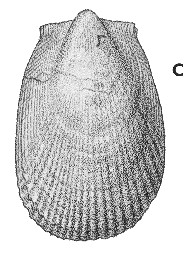
Revised descriptions of New Zealand Cenozoic Mollusca from Beu and Maxwell (1990)

 | Revised descriptions of New Zealand Cenozoic Mollusca from Beu and Maxwell (1990) | 
|
  (Pl. 17c): holotype, GS3188, K34/f9073, Porter River, Castle Hill Basin, Canterbury, Altonian (TM5502, GNS) |
Beu & Maxwell (1990): Chapter 11; p. 182; pl. 17 c.
Synonymy: "Lima jeffreysiana Tate" of Suter in Speight 1917, p. 348, 354 (in part); Limatula (Stabilima) jeffreysiana exulans Fleming 1978, p. 68
Classification: Limidae
Description: Large for genus (height 35-42 mm), equilateral, strongly inflated. Dorsal margins moderately long, sloping away from umbones; ears well defined, bounded below by shallow concavity in shell margin. Median radial sculpture of 18-24 narrow, well spaced, triangular-sectioned costae, almost smooth except distally where they become slightly nodulose or scabrous. Anterior and posterior areas with 9-20 much finer, beaded radial costellae, separated from median costae by zones without definite radial sculpture. Commarginal sculpture of growth ridges. Resilifer very large, projecting below cardinal area.
Comparison: Limatula exulans is distinguished from other New Zealand Limatula species by its relatively large size, although it is rivalled in this respect by Recent specimens of L. maoria from the Chatham Islands, in having distinct ears, and in having radial costellae on the anterior and posterior areas of adult shells (absent from adults of L. maoria). Fleming (1978, p. 68-69) considered this species to be closely related to the Australian Miocene species L. jeffreysiana Tate, 1885, differing from it primarily in its larger size and in sculptural details.
Limatula ranges from Late Cretaceous (Piripauan) to Recent in New Zealand and is represented by numerous species, most of which require careful examination for identification (see Fleming 1978). Beu & Maxwell (1990) did not follow Fleming (1978) in ranking New Zealand taxa as subspecies of overseas species, and considered the successional members of some species groups (which may represent evolving lineages) to be discrete species, rather than chronosubspecies.
Distribution: Altonian, shellbed at base of Enys Formation, junction of Porter and Thomas Rivers, Castle Hill Basin (type) (not uncommon).
Cite this publication as: "A.G. Beu and J.I. Raine (2009). Revised
descriptions of New Zealand Cenozoic Mollusca from Beu and Maxwell (1990). GNS
Science miscellaneous series no. 27."
© GNS Science, 2009
ISBN
978-0-478-19705-1
ISSN 1177-2441
(Included with a PDF facsimile file
copy of New Zealand Geological Survey Paleontological Bulletin 58 in CD version
from: Publications Officer, GNS Science, P.O. Box 30368 Lower Hutt, New
Zealand)